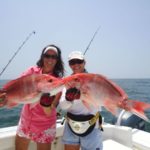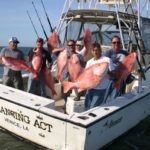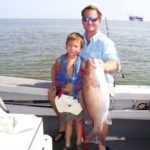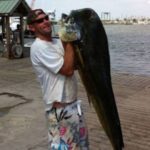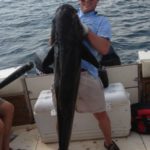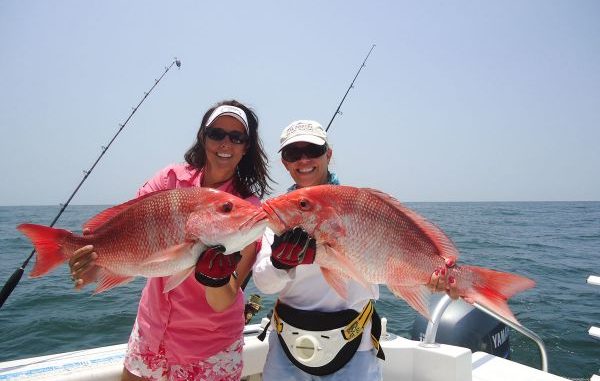
Redfish and trout might get most of the glory in the annual STAR, but don’t forget about the offshore categories. Here are tips from last year’s winners.
A staple in the summertime plans of many Louisiana saltwater anglers has been CCA Louisiana’s Statewide Tournament and Anglers Rodeo, a summer-long, multi-weigh station event stretching from the Texas state line all the way to Mississippi.
This year marks the 20th year the tournament has been in existence, and while the main focus has been geographical divisions in the speckled trout category and the tournament’s tagged redfish event — and its annual woulda, coulda, shoulda tales of non-entry captures — the STAR also offers offshore enthusiasts chances to get in on the action.
Specifically, STAR anglers can win$5,000 offshore tackle packages by weighing the heaviest fish in red snapper, mangrove snapper, cobia and dolphin.
The genesis of the offshore division predated STAR tournament director Rad Trascher’s time with the organization, but he’s since played a role in tweaking it as it has settled nicely into the four species of today’s event.
“CCA Louisiana was trying to reach a more broad group in our membership drive, which is basically what STAR is,” Trascher said. “These four categories are available to most offshore boats in the state.”
The cobia category was added in 2000, red snapper followed in 2001 and dorado in 2003. Mangrove snapper, with its perfect blend of proximity and baggage-free regulations, made its debut in 2007.
Past regulatory issues with amberjack and the logistical headaches associated with the yellowfin tuna category have scuttled inclusion in current iterations.
The tuna category started with a bang in ’05 with a 175-pound specimen, topped that the following year with a 184-pound fish and sizzled in ’07 with a 233.25-pound bruiser landed by Scott Pecue at Sand Dollar Marina in Grand Isle.
“Those were great fish, and obviously we loved seeing them, but we have to outfit each of our weigh stations with equipment capable of handling fish like that, so that was an issue,” Trascher said.
Trascher did say the tournament will only accept red snapper entries during the federally mandated recreational season. So any claims for the treasure trove of offshore tackle will have to come from the slim time period when federal regulators deem it legal to play ball.
To help you get a leg up on the competition, Louisiana Sportsman asked the 2013 offshore division winners about how they caught their winning fish and what advice they would offer participants in this year’s derby. Here’s what they said.
Red snapper
Jaevon Riley wasn’t even really targeting snapper last summer when his prize-winning fish was caught. A buddy had informed him that he had located some good fish in about 200 feet of water a few days previous, but the target that day was principally cobia.
“We were actually jigging for lemonfish,” the 27-year-old Mississippi angler said. “We’d caught a few black snapper (aka mangroves), but there turned out to be a pretty good bunch of big red (snapper) down there.”
Dropping a white snapper jig tipped with a pogie through clouds of smaller red snapper, Riley was able to wrestle the right fish to the 25-foot Contender.
Although the way he tells it, it sure didn’t seem that way at the time.
“I lost a big one in the rig and lost two bigger fish than the winning fish at the boat,” Riley said of the 26.35-pound fish. “I hooked her at about 70 feet down. All of the big ones we caught were between 60 and 75 feet.
When asked what he recommends for targeting the kind of red snapper that will contend for the prize package, Riley said that, contrary to popular belief, big snapper will often hang lower in the water column than smaller fish.
“You’ve got to remember, a smaller red snapper — even those up to about 10 pounds — are prey in that deep water. Amberjacks, sharks, even bigger red snapper will eat them,” Riley said. “They’ll hang higher than most of the big fish.
“The key is get the bait past the smaller ones.”
Riley accomplishes this by using a line counter on his reel. The first fish he hooks are almost always the smaller ones. Subsequent drops get him past the school and into the domain of the trophies.
Mangrove snapper
The legacy of the vessel Reel Bad Habit is that of winning, at least in the mangrove snapper division. With a winning fish in 2009 and a runner up in 2012, Brent Fay had indisputable bragging rights among the regular crew aboard the 30-foot custom Gaudet, which typically fishes out of Venice.
Keith Haslauer, a 43-year-old medical professional from St. Rose, figures he’s tied the score in the category that really counts, though, as he weighed 2013’s winning 12.79-pound beauty on a typical offshore trip last summer.
The crew loves to fish for red snapper, but they also like to fill the fish box with more than what a two-fish limit can accomplish. Mangroves have been a target for some time because of their liberal limits, sweet meat, and often-challenging demeanor in getting them to bite and getting them out of the barnacle-covered oil and gas platforms.
“We were at Main Pass 299. I was at the bow, and the water was good,” Haslauer said of the early June trip. “We were having a pretty good day: We ended with a limit of red (snapper), a few grouper and scamps, 20 or so good mangroves.
“We threw out some chum, he hit it, I stuck him and ran to the stern to fight him.”
The fish was one of two very healthy snapper — one weighing about 11.5 pounds and the STAR winner — he caught back to back.
He also didn’t weigh the biggest fish immediately, citing fatigue from a long day on the water and the myriad chores associated with closing the book on such a trip.
Haslauer said one of the more-important things in catching mangroves is water clarity. Watching fish in clear water is fun in and of itself, but giving yourself a chance to land them in good numbers requires something else.
“You want the water to have a little murk layer to it,” he explained. “You can still see the fish from time to time flashing through the chum, but being able to see the fish clearly is not the best.”
Proper tackle also is important.
“You want to use good, strong leader material to get them out of the rigs,” Haslauer said. “I like to rig 80-pound fluorocarbon leader to 80-pound PowerPro with a Uni knot.
“If the water’s clear, you can go to a 50-pound leader, but that means more popped line.”
Popped lines mean more time without a hook in the water, as sometimes the entire leader has to be replaced. And rigging time can mean missing the hot bite.
Haslauer also said choosing and rigging the right bait is critical in getting the bites needed to put meat in the box.
“You want to take the pogie and cut off the tail, and then cut it again toward the head to form that nice, little triangle just wide enough to slide a 6/0 circle hook along the backbone,” Haslauer said. “You’re actually pushing the hook into the bait, not hooking it. That bait will fall naturally with the chum.”
Dolphin
More of a true blue-water fish than the other categories, dolphin can also show up when crystalline water draws closer to shore when Gulf current dynamics align. The result is often spectacular action from one of the prettiest, tastiest and hardest-fighting fish in the world.
The 2013 winner wasn’t close to shore at all, but it was caught in a somewhat random spot, although with wholly conventional tactics.
Thirty-three-year-old Humana sales rep Scott Rauch of Metairie was on rod aboard Dennis Antonatos’s 36-foot Contender on an overnight tuna trip when they spied a 10-by-10-foot patch of sargasso near the Nakika TLP many miles east of Venice.
“When we’re tuna fishing, we’re always looking for grass lines or color changes, and we always take along ballyhoo,” said Rauch, who regularly shares crew duties with Jonathan Ruffin and Keith Champagne in the summer months. “This wasn’t a great-looking grass patch, but it was loaded with dolphin.”
After deploying ballyhoo rigged with blue/white and pink/white Ilander trolling baits — the default dolphin catcher among Louisiana offshore anglers — two reels screamed on the first pass, and the crew made quick work of a pair of 25-pound-class fish.
Resetting the lures with fresh ballyhoo, the boat made another pass, and this time two 30-pounders did their best to set the Gulf ablaze with typical dolphin-like histrionics.
The crew was pumped with their haul and set out the baits a final time.
It was Rauch’s time on the reel that went off when a prize-winning 51.80-pound bull took to the air before settling in for a steady give and take, using its broad midsection and head to dissuade any progress on the reel before finally succumbing to the gaff’s endgame.
The order of the catches is peculiar for many who subscribe to the “big-dog-eats-first” theory. But Rauch said with mature, adult dolphin, all bets are off.
“They’re such an aggressive fish. And the ones we were catching weren’t small,” he said. “It was more of a random thing.”
Rauch said one of the keys to finding dolphin that will contend for this year’s prize package is to move. A lot.
Dolphin are among the Gulf’s fastest fish to the bait, the fastest-growing fish and the fastest-moving fish, going wherever there’s bait. That could be the first color change or one many miles over the horizon.
“Just because you think you’ve found the rip doesn’t mean you’ve found the one with the fish on it. There are usually several color changes and grass lines out there,” Rauch said. “You’ve got to have chicken dolphin (juveniles) and flying fish and other bait on that line or the bigger fish will find a place that does.”
Cobia
Russell Freeland no longer makes his home in South Louisiana, but the large-animal veterinarian now practicing in upstate New York will always have the waters south of Freshwater Bayou in heart.
And he can’t wait to get down here this summer to try and top the 73.59-pound lemonfish caught aboard his father’s boat last summer.
That fish was a personal best and the winner of the division for 2013.
Offshore fishing out of the western half of the state always means long rides to the fishing grounds, since the Gulf floor gently tapers to appropriate depths for the targeted species.
This has its good points and its bad points, but what it definitely does is cut down on the amount of competition — especially for cobia.
“If I’m fishing at a rig and there’s another boat on it, that’s a rare thing,” Freeland said. “That’s what makes these fish a little more available to us over here: They just don’t get caught or bothered as much as they do on the other end of the state.
“If we’re 80 miles out, we’re still in about 160 feet of water.”
Freeland’s big fish came before the prime fishing grounds had been reached while the rest of the crew was trying to catch hardtails for bait.
Some live bait had already been secured, so he lowered a hardtail down in hopes of tempting one of the two cobia he’d spied upon pulling up to the rig.
“I didn’t see that fish, but there were two that were near the surface when we pulled up and then immediately went down,” Freeland said. “He hit it pretty close to the bottom.”
When the fish came into view — still some ways away from the boat — Freeland knew he had a good fish, and all lines were cleared. With some careful maneuvering, the winning fish was soon dispatched into the fish box, and the day’s fishing continued.
Freeland said a few things can tip the odds in anglers’ favor when targeting big cobia. Preparation and being nimble is key in taking a shot when a shot is available to be taken.
“I’m looking hard at the rig when we first pull up. And if I see fish on the surface, I’m able to cast a good live bait to them almost immediately,” said Freeman, adding that live hardhead catfish with the spines clipped off are a bait of choice. “It helps a lot to use a rod and reel you can cast a good live bait with.
“The first presentation is critical.”
Should the first strike prove unsuccessful, Freeland said stealth plays a key role in making fish bite.
“Fluorocarbon is your friend, and I don’t like to use a weight or swivel attaching it to the main line,” he said. “It’s almost like rigging for mangrove snapper fishing: You never know what kind of mood they’re going to be in.”
